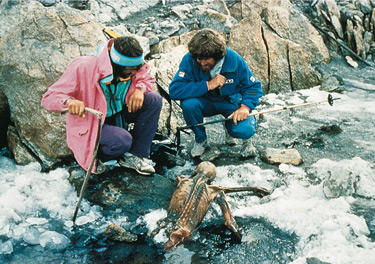Also, you will view pictures of a mummy. Plan your meals accordingly.
*
Bolzano Bozen's bi-lingual status isn't the only reason it's an interesting city to visit; Bolzano also boasts a museum dedicated to a 5,000-year-old mummy named Ötzi.
The South Tyrol Museum of Archeology tells the story of Ötzi, a man who lived in the Ötztal Alps in what is now Northern Italy. In 1991, two German hikers happened upon his body, and after contacting authorities, a team assembled to excavate the corpse and his belongings. Once out of the ice, scientists began studying the "Ice Man," and as they ran more tests, they realized that the corpse was older than they originally thought - a thousand years older. Ötzi became the oldest human corpse ever found.
Ötzi's body survived because the snow and ice of the Ötztal Alps that covered him prevented decomposition and disturbance from predators. His location, deep in a gully, also protected him from the movement of the glacier, which essentially flowed over him. Despite our changing climate over the past 5,000 years, several fortunate circumstances preserved Ötzi, and he in turn has provided scientists with mountains (pun-intended) of data and insight into what life was like thousands of years ago.
Getting in: We decided to visit the museum right when it opened at 10 o'clock. On previous days, lines had formed in the late afternoon, and we didn't want to waste time waiting in a line. There are too many museums to visits and too many gelato flavors to sample for that! We arrived at 9:50, and an Austrian family joined us soon after. Being the reserved Americans (not an oxymoron) that we are, we waited for the doors to open. But not this robust Austrian man! He tried the door and then used the intercom. The doors unlocked, he laughed with good-natured pride, and we entered the museum in mummy-beholding anticipation. The receptionist must have thought the man on the intercom was making a delivery, because she kind of looked shocked that a group of people entered the museum, say, two minutes before it was set to open. As my mother would say, "the squeaky wheel gets the oil." Lessons learned? 1. If you're a customer, it never hurts to ask for what you want. 2. You can't keep Austrians waiting. They won't let you.
The first floor of the museum set the stage for meeting Ötzi on the second. To put Ötzi's time period in perspective, the museum had a timeline that noted major events in Earth's history. Ben had to pose with his predecessor, Lucy. And check out those neon-colored humanoids in the background!
After prying ourselves away from Ötzi, we had a look at the clothing and supplies that were discovered with him. Note that the photos of Ötzi and his belongings are from the museum's website since no photography was allowed on this level of the museum. If you're interested, the website details each of the items found with Ötzi, and offers great information about the research done on him. Do you want to know about the contents of Ötzi's stomach? What about the blood in his veins and his blood type? All this and more on the website.
Multiple choice: The above photo is ___.
a.) an axe with a copper blade b.) a dangerous cane c.) rewriting history books d.) a primitive tool for primitive lobotomies
So, a.) and c.) - Ötzi's axe blade is indeed made of copper, but because scientists have dated Ötzi's existence to over 5,000 years ago, they now know that the Copper Age in Europe began one thousand years before the old estimates. All by finding one artifact...
If you answered b.) and/or d.), really?
Ötzi wasn't messing around in the mountains; the man knew how to dress. These leggings were found on Ötzi, and they're made from goat hide and deerskin string. We could actually see fur on the leggings.
In addition to the sewing on the leggings, viewing the dagger and sheath really drove home the fact that Ötzi was a skilled craftsman. If something broke on his journey, he had to be able to repair it. For him, it meant the difference between life and death. Each of his belongings seemed to have been made from different types of animals, wood, and grains. He obviously had naturalistic intelligence and used his resources wisely. He made the most of what was available.
It reminds me of how little I know about surviving. Could I build a fire? A shelter? Could I protect myself? Find food?
Could you?
Well, the Ötzi story isn't completely filled with axes and craftsmanship. Why?
Because Ötzi was MURDERED. What? I know!
About ten years after he was discovered, an X-ray found that an arrowhead was lodged in his shoulder. They believe that this wound killed Ötzi. To make the museum a bit interactive, clipboards were attached to a wall where one could write her interpretation of how Ötzi died. We added our stories, natürlich. My favorite was from an Irish visitor, and it read: "Ötzi was murdered by his best friend Chika - he was jealous of his smooth hair and dagger collection. He -(Ötzi) - died with dignity." Another great one that Ben translated for me said that Ötzi was killed by dinosaurs, and the "arrowhead" they found in his shoulder is actually a dinosaur tooth.
I'm not so sure that these young writers came to their conclusions based on the evidence available (as good researchers do), but some points must be given for creativity.
And the lifelike model of Ötzi that ties everything together.
- Select photos and information via.












No comments:
Post a Comment